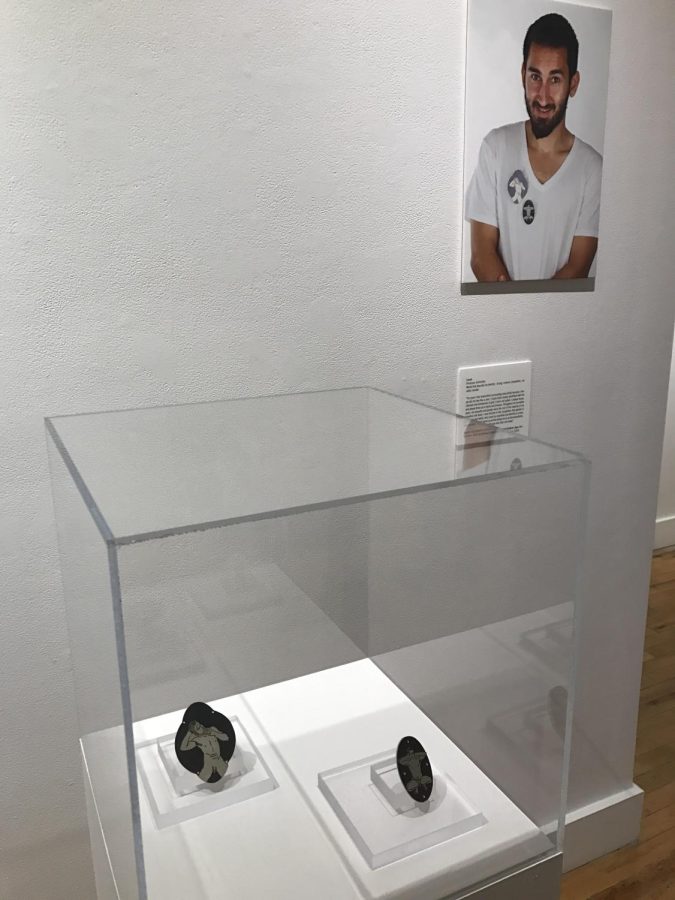‘Jewelry and Gender’ exhibit connects artwork, models, community
November 3, 2018
An extravagant, double-layered necklace — jutting bright yellow and orange tree branches and florals out of it — rested on a mannequin and cast an intricate, botanical shadow on the wall of the KSU Downtown Gallery.
Kent State alumna Rachel Smith made this piece of jewelry. “Primrose Ruff,” the name of the artwork, was on display for the “Jewelry and Gender: Challenging the Norms” exhibition, which had its opening reception Friday evening.
Smith said the piece was originally created before the exhibit was planned, but it still related to the ideas of identity and expression.
The primroses used in this piece are based on the flowers that used to grow in Smith’s garden when she was a child. The primroses were never planted, though; instead, they used to grow up in the cracks and were seen as unwanted.
“We tend to try to have everything be perfect,” Smith said. “I thought that by making something really beautiful out of flowers that might typically be eradicated … it kind of allowed people to become more accepting of those different wildflowers as well.”
While on display at the gallery, the piece takes on a whole new meaning related to identity and expression. “Jewelry and Gender: Challenging the Norms” is comprised entirely of art jewelry. The goal of the exhibit is to challenge gender norms and explore various gender identities.
All of the art pieces were created before the theme was planned, and their original meanings were adapted to be a mode of gender expression.
In a case along a different wall of the gallery rested a more subtle piece in muted tones.
Two broaches with nude figures, pieces by Andrew Kuebeck — an assistant professor of jewelry, metals and enameling in the School of Art — show different men, individual in their physiques and body language.
Originally the pieces, entitled “Keyhole Culture: Joey” and “Keyhole Culture: Ken,” addressed the idea of society being “unapologetically voyeuristic” and willing to dissect others’ lives, Kuebeck said.
“I wanted to take these kind of private, still moments and then have people actually wear them, almost representing that they are a voyeur,” Kuebeck said. “They are consuming someone else’s life. That’s where the imagery came from. And then the format is all different shapes of traditional keyholes like you’d look through to spy on somebody.”
Kuebeck’s pieces, along with the others in the gallery, were modeled by a local member of the LGBTQ community. Roza Maille, the curator of the exhibition and the marketing assistant for the School of Art, paired the jewelry with the models based on the struggles and successes the models said they had with their identity.
Amy Klainer’s piece, “The System (Traffic Orange, Mainline Green, Signal Blue),” is a large necklace made of industrial-sized cables joined together by what, on first glance, appear to be colorful, enlarged safety pins. Luca Taylor, a second-year graduate student majoring in printmaking, modeled Klainer’s piece.
“For Luca’s, they talk about how there’s a lot of tension in their family because they changed their name, and their family doesn’t want to use their chosen name,” Maille said. “I was thinking these cables might represent that tension. If (the model) stated that they were a very feminine person or a very masculine person, I took that into consideration.”
In addition to the jewelry serving as a representation of Taylor’s struggles, Taylor also relates to the concept of clothing being a representation of identity.
Taylor is non binary and expresses themself with neutral colors. Klainer’s piece predominantly featured earthy tones.
While the pieces in the gallery connected to the models’ lives, the gallery as a whole was meant to connect communities.
“I think (the exhibition) brings people together,” said Marie Bukowski, the director of the School of Art. “I think that the ultimate goal of this exhibition was to really start to open up that dialogue, to be really inclusive, whether you are LGBTQ or an ally or not even knowing where you fit into all of that, but to just be that inclusive … and really get everybody together as a community.”
Kuebeck said starting a dialogue about gender identity is beneficial in creating more acceptance.
“I think little things like this (exhibition) on the local level do give people the opportunity to become a little more normalized, and I think (with) normalization, then you can actually further causes to move onto the next step,” Kuebeck said. “Because eventually, talking about gender and pronouns isn’t going to be an issue. It’s going to be the next thing that’s going to help people have a little bit of an easier time living their lives however they want.”
The exhibit will be at the KSU Downtown Gallery at 141 E. Main St. until Dec. 1. The gallery’s hours are Monday through Friday 9:30 a.m. to 6 p.m. and Saturday 10 a.m. to 4 p.m.
Alexandra Sobczak is the arts and architecture reporter. Contact her at [email protected].












